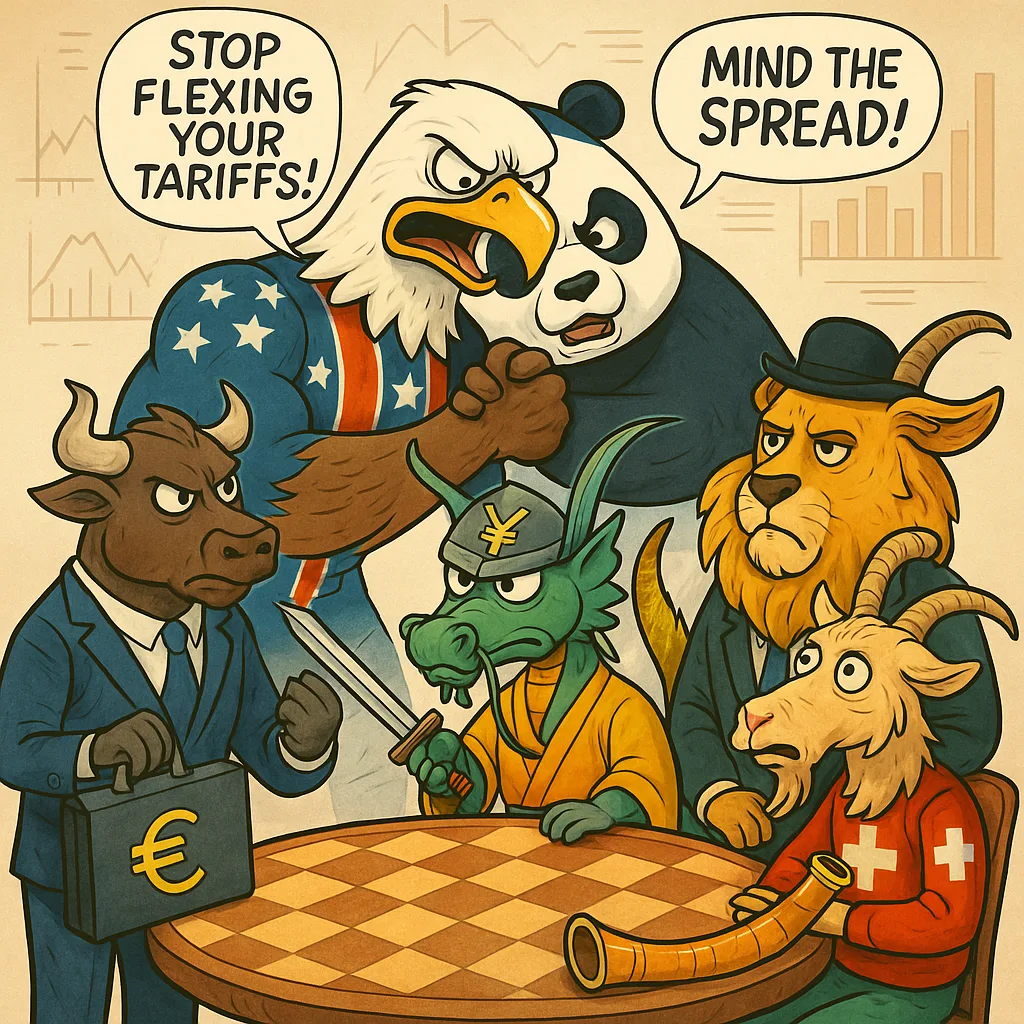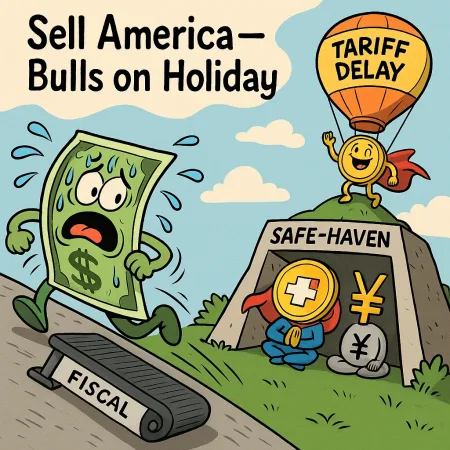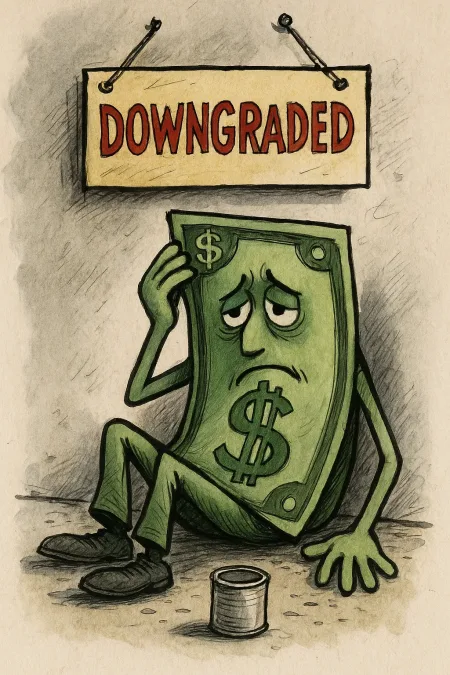Forex Market Outlook: Week of May 10–16, 2025
Forex Markets (Top 5 FX Pairs)
Trade Talks and Data in Focus: Currency markets are bracing for a volatile week as U.S.-China trade negotiations unfold in Geneva amid low expectations for a breakthrough. Washington’s hefty tariffs (145% on Chinese imports, met with 125% retaliatory tariffs from Beijing) form a tense backdrop, driving safe-haven demand into currencies like the Japanese yen and Swiss franc. Traders are also eyeing key economic data – notably the U.S. April CPI on May 13, expected at a modest +0.3% monthly (2.3% year-on-year) – alongside central bank speeches for clues on policy direction. With inflation in the U.S. (~2.4% and easing) and eurozone (~2.2%) near target levels, markets anticipate a continued cautious stance from policymakers even as global growth forecasts have been trimmed due to tariff impacts.
-
EUR/USD: The euro remains under pressure. Eurozone inflation held at 2.2% in April, but the European Central Bank is expected to cut rates further to shield growth from the trade war’s fallout. In fact, futures imply ~85% odds of an ECB rate cut at the June meeting. This policy divergence – with the Fed on hold at 4.5% and the ECB easing – has pushed EUR/USD into a third straight week of losses. Near-term, the pair may stay weak; a short positioning bias is favored on rallies, given Europe’s export exposure to tariffs. Recommendation: Cautious shorts on EUR/USD could be maintained in the short term, while a U.S.-China deal (if reached) might warrant partial profit-taking as global sentiment improves.
-
USD/JPY: The dollar has been strong against the yen, benefiting from a slight revival in risk appetite and Japan’s ultra-loose policy. Last week the greenback was on track for a weekly gain against both yen and franc. The Bank of Japan remains accommodating (with no tightening in sight), making the yen a funding currency that weakens when optimism flickers. However, safe-haven flows are quick to return to JPY on bad news. If the trade talks disappoint or geopolitical tensions rise, USD/JPY could retreat as investors seek safety. Recommendation: Maintain a long USD/JPY bias while trade optimism persists, but hedge with call options on yen (or reduce longs) ahead of any critical headlines, as a collapse in negotiations would send yen surging.
-
GBP/USD: The British pound has shown resilience after the Bank of England’s surprise split decision to cut rates by 25 bp to 4.25% on May 8. Sterling initially slipped on the BoE’s easing, but then rallied as two MPC members dissented against cuts – a hawkish signal that caught traders off guard. By week’s end, GBP/USD was higher, around $1.33, securing a weekly gain. Going forward, the pound faces cross-currents: BoE’s dovish tilt (aimed at cushioning the tariff-related growth hit) could cap gains, yet any positive developments in global trade talks tend to favor the growth-sensitive pound. Recommendation: A neutral to mildly bullish stance on GBP/USD is warranted. Dip-buying could be considered on any retracement toward $1.30, with a stop below $1.28, as the UK’s inflation outlook (2.6% and rising to ~3% on energy costs) may keep the BoE from aggressive easing beyond this initial cut.
-
USD/CHF: The Swiss franc, like the yen, serves as a barometer of risk sentiment. It weakened against the dollar last week as hints of trade progress lifted risk appetite slightly. The Swiss National Bank has been quietly aligning policy with the ECB to prevent CHF overstrength; with the ECB cutting, the SNB maintains an ultra-low rate regime. If trade tensions escalate again, CHF will likely firm (USD/CHF down) on safe-haven inflows. Conversely, any constructive news from the U.S.-China talks could see USD/CHF testing higher. Recommendation: Traders may consider long USD/CHF positions in the short term, targeting the mid-0.90s, but should tighten stops or switch to long CHF (against USD or EUR) if negotiations sour or global equities slump, as the franc would rapidly regain strength.
-
AUD/USD: The Australian dollar is the most China-sensitive of major currencies. It has been subdued, reflecting soft Chinese economic data (China’s factory-gate prices are mired in deflation) and fears that prolonged tariffs will hit Australia’s commodity exports. That said, any sign of détente in the trade war could spark a sharp AUD relief rally. The Reserve Bank of Australia, which held rates steady recently, could even lean hawkish if global risks abate. Recommendation: Event-driven strategy is key for AUD/USD. In the short term, stay defensive – perhaps using options – given downside risks if talks fail. For medium-term investors, accumulating AUD on weakness (below $0.70) with an eye toward a trade deal or Chinese stimulus could prove wise, as the currency is undervalued on a fundamental basis. A successful U.S.-China negotiation would likely propel AUD/USD higher (back toward $0.75+).
Overall, short-term FX positioning should remain nimble and risk-managed. The U.S. dollar index has been firmer amid global uncertainty (notching its first weekly gain this month), and the greenback may extend gains versus trade-sensitive currencies until clear progress is seen. Yet, the dollar slipped late last week as optimism tentatively grew on a U.S.-UK mini-deal and the mere prospect of China talks. Medium-term, if the tariff overhang is resolved, we could see a rotation: risk currencies (AUD, NZD, EM FX) outperforming, and safe havens (JPY, CHF, USD) giving back some gains. Thus, traders should be prepared to pivot when concrete news hits – maintaining core hedges like long JPY or gold (via FX proxies) until a comprehensive trade truce is firmly in sight.
Check out more Forex Trade Setups on our forex page.
Please visit our Disclaimer page.
Disclaimer
Information on these pages contains forward-looking statements that involve risks and uncertainties. Markets and instruments profiled on this page are for informational purposes only and should not in any way come across as a recommendation to buy or sell in these assets.
You should do your own thorough research or engage the services of a registered financial markets professional before making any investment decisions. TerraBullMarkets.com does not in any way guarantee that this information is free from mistakes, errors, or material misstatements. It also does not guarantee that this information is of a timely nature. Investing in Open Markets or any financial instrument involves a great deal of risk, including the loss of all or a portion of your investment, as well as emotional distress.
All risks, losses and costs associated with investing, including total loss of principal, are your responsibility. The views and opinions expressed in this article are those of the authors and do not necessarily reflect the official policy or position of TerraBullMarkets.com nor any of its advertisers. The author will not be held responsible for information that is found at the end of links posted on this page.
If not otherwise explicitly mentioned in the body of the article, at the time of writing, the author has no position in any stock mentioned in this article and no business relationship with any company mentioned. The author has not received compensation for writing this article, other than from TerraBullMarkets.com.
TerraBullMarkets.com and the author do not provide personalized recommendations. The author makes no representations as to the accuracy, completeness, or suitability of this information. TerraBullMarkets.com and the author will not be liable for any errors, omissions or any losses, injuries or damages arising from this information and its display or use. Errors and omissions excepted.
The author and TerraBullMarkets.com are not registered investment advisors and nothing in this article is intended to be investment advice.




